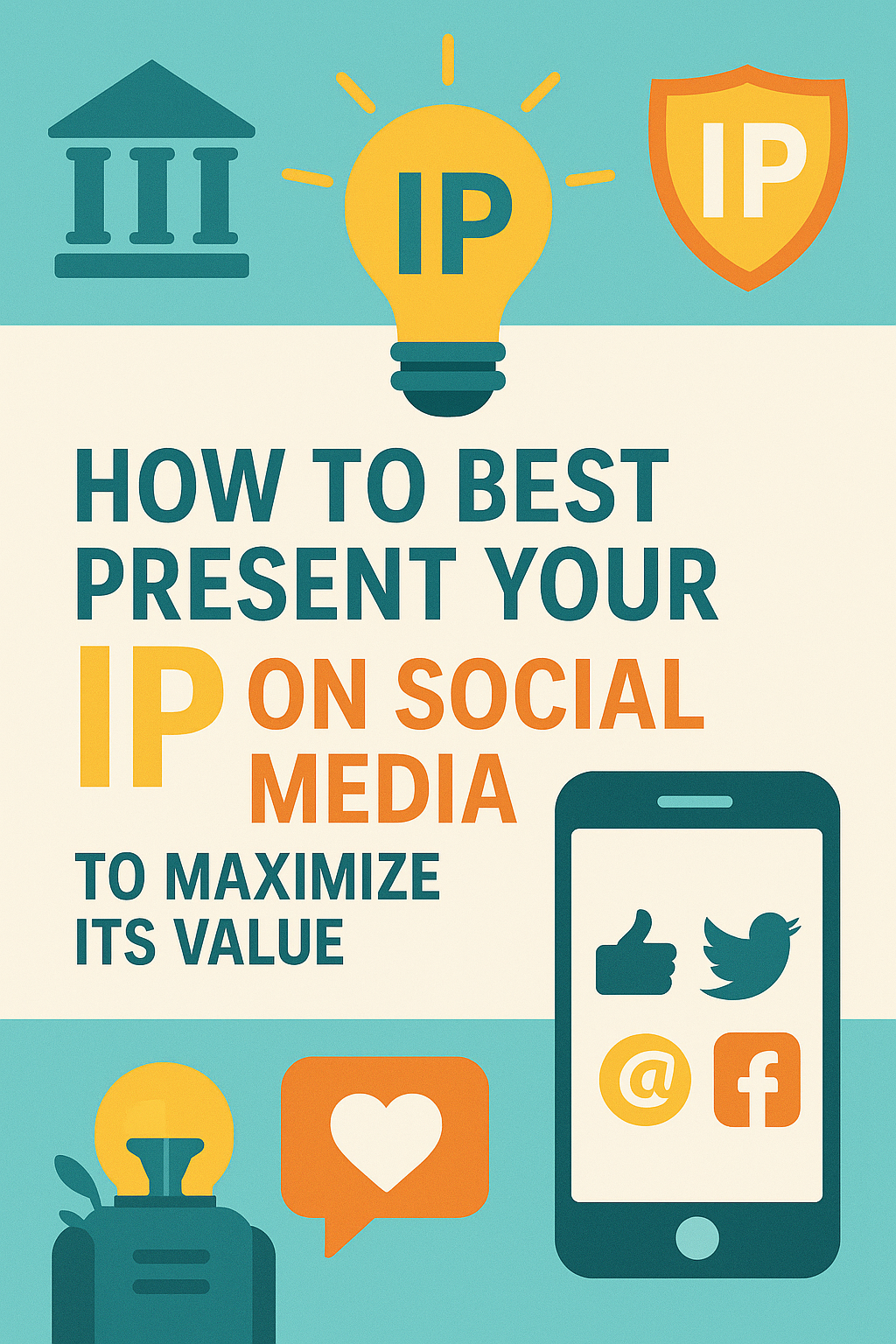📌 Quick Summary
1-Sentence Answer
Want to make your intellectual property shine? Use social media to spotlight, safeguard, and skyrocket your IP’s value, turning patents into profit and publicity!
The Article Overview
This article dives into smart, practical, and often hilarious ways to present intellectual property (IP) on social media, ensuring you attract attention, build credibility, and boost the value of your ideas—while keeping trolls at bay.
❓ Common Questions & Answers
Q1: Can I really promote my patent or IP on Instagram and LinkedIn?
A1: Absolutely! Sharing your IP creatively on social platforms boosts its visibility, attracts partners, and can even impress investors—just avoid sharing your secret sauce!
Q2: How do I prevent my IP from being copied online?
A2: Watermark images, use partial reveals, and always mention your registration status (e.g., “Patent Pending”). And never post your entire blueprint unless you enjoy free crowdsourcing!
Q3: What if my followers don’t “get” my invention?
A3: Break it down with analogies, videos, or memes. If all else fails, invent a new emoji to explain it. The simpler and more relatable, the better.
Q4: Should I use hashtags for my IP?
A4: Definitely! Branded hashtags like #MyPatentIsCool can help your innovation stand out and even start trends—just keep it relevant and a little bit quirky.
Q5: Can social media really add value to my IP?
A5: 100%! Social buzz creates perceived value, attracts media, and even scares off copycats. Your IP’s “cool factor” counts in the digital age.
📜 Step-by-Step Guide
Step 1: Secure Your IP
Before showing off, make sure your patent, trademark, or copyright is registered or pending. Legal protection first—showboating later.
Step 2: Create Shareable Content
Develop engaging posts—think infographics, teaser videos, or “making-of” reels. Show how your IP works, but keep the magic trick a secret.
Step 3: Use Storytelling
Share the origin story of your invention or brand. Audiences love a hero’s journey (even if your hero is a self-cleaning cat bowl).
Step 4: Leverage Visuals
Good visuals are gold. Use high-quality images, fun diagrams, and branded graphics to make your IP scroll-stopping.
Step 5: Engage with Comments
Answer questions, thank supporters, and cleverly dodge trolls. Engagement increases reach—and helps you spot your biggest fans and potential collaborators.
Step 6: Track & Adjust
Monitor likes, shares, and feedback. Double down on what works; ditch the duds. Data turns publicity into profit.
📖 Historical Context
The idea of promoting intellectual property is not new, but the methods have evolved faster than you can say “retweet.” Back in the industrial revolution, inventors relied on expos, patent gazettes, and—if they were lucky—a shoutout from Thomas Edison. Fast forward to the age of TV and radio, and patent holders could demo their creations live, sometimes with hilarious (and occasionally dangerous) results. Early adopters of televised “infomercials” in the 1980s often found that a single viral commercial could skyrocket a product from obscurity to household fame—“as seen on TV” became its own intellectual property goldmine.
With the rise of the internet, IP owners found new frontiers. The 1990s and 2000s saw innovators using personal websites and email newsletters to connect with niche audiences. But nothing compares to the current digital landscape, where a single viral TikTok or LinkedIn post can transform an unknown patent into a must-have gadget or trending meme. The challenge, of course, is standing out in a sea of content. Unlike the past, today’s inventors must compete not just with rivals, but with dancing cats, life hacks, and meme stocks. This means combining solid IP protection with next-level creativity, storytelling, and savvy social media use is not just an advantage—it’s a necessity.
Social media has democratized promotion but also heightened risks, from copycats in faraway lands to internet trolls looking for their next target. IP owners must balance the urge to share with the need to protect, navigating everything from platform rules to international audiences. Yet, the opportunity to turn a clever post into real-world value—and maybe a licensing deal or two—has never been greater. The future? Expect even more wild, weird, and wonderful ways to showcase your IP, as long as people love to scroll.
🏢 Business Competition Examples
-
Dyson’s Patented Cyclonic Vacuum:
Dyson uses slick social media campaigns to visually demonstrate its patented technology, creating buzz and fending off imitators. -
Oreo’s “Dunk in the Dark” (Trademark):
Oreo’s quick, witty posts leverage their trademark status, making the brand part of viral conversations and boosting the perceived value of their IP. -
Tesla’s Autopilot Features (Patents):
Tesla posts regular updates and behind-the-scenes content about its patented self-driving technology, turning technical IP into fan-friendly social moments. -
Disney’s Character Copyrights:
Disney runs ongoing, interactive social campaigns featuring its copyrighted characters—think #MayThe4thBeWithYou—reinforcing brand and IP value.
💬 Discussion Section
Presenting intellectual property on social media is both an art and a science, blending creativity, legal strategy, and audience psychology. First, every social post is a potential opportunity to educate and excite your audience—not just about your IP, but about the broader mission and vision of your brand. The most successful campaigns aren’t just about bragging rights; they invite the audience to share in the story, build community, and—even better—become ambassadors who help spread the word.
Consider the emotional connection people form with a brand that openly shares its journey from napkin sketch to patented product. When an inventor tells the tale of late nights, failed prototypes, and eventual success, followers become invested not just in the “what,” but the “why.” Social media lets you pull back the curtain—showing the messy, relatable side of invention—and that authenticity translates into trust. But there’s a fine line: too much transparency can make you a target for copycats. That’s why clever inventors show just enough to intrigue without revealing their secret sauce.
Platforms matter, too. LinkedIn might be best for industry insights, patent updates, and connecting with collaborators, while Instagram and TikTok reward eye-popping visuals and viral challenges. X (Twitter) thrives on short, witty updates and can get your patent trending in the right circles. Each platform has its own “IP vibe”—the trick is tailoring your message to fit the audience while staying true to your brand voice.
The value-add of social media isn’t just about the number of likes or retweets. It’s about social proof. When real users, partners, or even celebrities engage with your posts, your IP’s perceived value increases. Suddenly, it’s not just your mom who thinks your invention is cool—it’s the whole internet. This social validation can attract investors, media coverage, and even licensing deals, supercharging the real-world value of your intellectual property.
But don’t forget the risks! Oversharing can make you a target for idea thieves, trolls, or—worse—keyboard warriors with nothing better to do. Smart IP owners find the sweet spot: they reveal enough to get the crowd buzzing, but not enough to be reverse-engineered by a determined competitor. Tools like watermarks, partial reveals, and legal notices (“Patent Pending!”) help protect your ideas while building buzz.
Finally, remember to measure your success. The best IP publicity campaigns are data-driven: track engagement rates, analyze follower growth, and monitor the conversation. Use this intel to refine your strategy—if cat memes get more shares than technical diagrams, give the people what they want! In short: the modern inventor who masters both patent law and meme culture is the one most likely to turn their IP into pure social media gold.
⚖️ The Debate
Side 1: Social Media is Essential for Maximizing IP Value
Advocates argue that social media is the fastest, cheapest, and most effective way to build buzz and value around intellectual property. By controlling the narrative and connecting with audiences worldwide, inventors can attract partners, investors, and licensing opportunities, turning an obscure patent into a household name overnight.
Side 2: Social Media Puts Your IP at Risk
Skeptics warn that posting about IP online invites copycats, trolls, and legal headaches. Once an idea is in the wild, controlling its use becomes harder. For some, the risks of being cloned or misrepresented outweigh the rewards of extra publicity, making traditional, more controlled marketing a safer bet.
✅ Key Takeaways
-
Social media can dramatically increase the value and visibility of your IP—if you post smartly.
-
Always protect your IP legally before sharing details online.
-
Storytelling and engagement build community and brand loyalty.
-
Each platform has its own strengths; tailor your approach accordingly.
-
Track results, stay flexible, and never reveal the secret recipe!
⚠️ Potential Business Hazards
-
Accidentally revealing trade secrets or patentable details.
-
Becoming a target for online trolls or negative publicity.
-
Having your IP copied or infringed upon by unscrupulous followers.
-
Misusing platform rules and losing your account or credibility.
❌ Myths & Misconceptions
-
“Posting about my IP online means everyone will steal it!”
-
“Only big companies benefit from social media publicity.”
-
“Legal protection isn’t necessary if you post first.”
-
“My IP is too boring for social media.”
-
“Social media is just for selfies and cat videos.”
📚 Book & Podcast Recommendations
-
Book: “Intellectual Property and Open Source” by Van Lindberg
-
Book: “One Simple Idea: Turn Your Dreams into a Licensing Goldmine” by Stephen Key
-
Podcast: “IP Fridays”
-
Podcast: “The Inventors Launchpad Network”
⚖️ Legal Cases
-
Apple Inc. v. Samsung Electronics Co.
Summary & Link
Famous for patent and design infringement battles played out both in court and on social media, showing the PR power of public IP disputes. -
Oracle America, Inc. v. Google, Inc.
Summary & Link
Highlights copyright and software IP issues and the global discussion it generated on social media platforms. -
Louboutin v. Yves Saint Laurent
Summary & Link
Trademark and brand value played out in public, impacting consumer perception via social channels. -
Chewy v. Yeti Coolers
Summary & Link
A recent case involving social media branding, demonstrating how online buzz affects IP enforcement.
📣 Expert Invitation
Have your own IP story or tip? Want to connect with fellow inventors, brand builders, and legal eagles? Jump into the discussion at Inventive Unicorn—where every good idea gets the spotlight it deserves!
🔚 Wrap-Up Conclusion
Turning your intellectual property into social media gold isn’t just possible—it’s practically required in today’s digital age. Protect it, promote it, and watch your IP sparkle!











